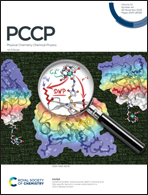From a bulk to nanoconfined water chain: bridge water at the pore of the (6,6) carbon nanotube
Abstract
Hydrophobic porous materials with nano-pores are critical in many processes such as water desalination and biological membrane transportation. Herein, we performed molecular dynamics (MD) simulations on a prototypical hydrophobic nanochannel consisting of a (6,6) carbon nanotube (CNT) of 4.12 Å in radius and 13.72 Å in length immersed in water. The simulation shows that there are two major filling numbers of water N = 5 and N = 6, with the former being the most stable one. The confined waters form a single-file water chain with two hydrogen bonds per water. An extending water chain is formed for N = 5, with a bridge water near the pore of the CNT linking the water confined inside the CNT and hydration layer around the pore of the CNT. The bridge water can be considered as intermediate water characterized by three hydrogen bonds that distinguish from the confined water and bulk water. On the other hand, the hydration layer is depleted from the pore when N = 6. The analyses of the correlation of the bond order for the adjacent hydrogen bond pair of the hydration layer around the pore of the CNT does not show apparent difference from that of bulk water, though the former is slightly ordered. van Hove analysis of the bridge water shows that it tends to move inside the CNT when N < 5, in order to maintain the chemical equilibrium between the confined water and bulk water. This study highlights the unique structure of water around the hydrophobic pore of a sub-nanometer nanochannel.



 Please wait while we load your content...
Please wait while we load your content...